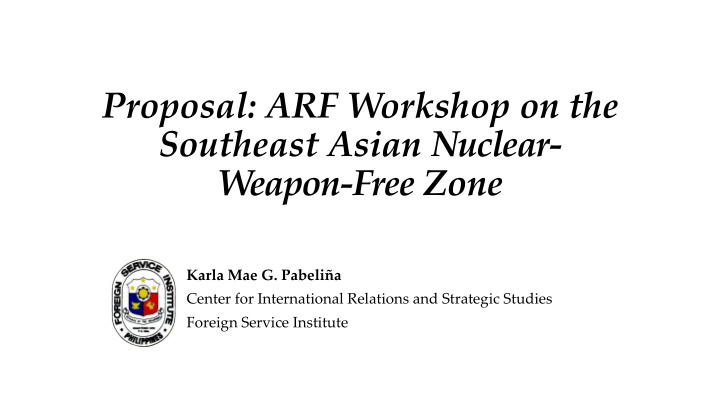



Proposal: ARF Workshop on the Southeast Asian Nuclear- Weapon-Free Zone Karla Mae G. Pabeliña Center for International Relations and Strategic Studies Foreign Service Institute
Background • Two decades have passed since the entry into force of the Treaty on the Southeast Asian Nuclear-Weapons-Free Zone (SEANWFZ) yet the path towards its full implementation continues to be beset by geostrategic and political challenges. • Its evolution stems from the 1971 Declaration on the Zone of Peace, Freedom and Neutrality (ZOPFAN). • The SEANWFZ embodies the “collective will and concrete action of the ASEAN member-states to keep Southeast Asia free of nuclear weapons and therefore contribute towards general and complete disarmament. ” • Underlying the full and effective implementation of the Treaty is the signing and ratification of its Protocol.
Background • The Treaty of Bangkok’s objectives were further affirmed in the ASEAN Charter as it seeks to preserve Southeast Asia as a zone free of nuclear and all other weapons of mass destruction (WMD). • The ASEAN Vision 2025 reaffirms this need to preserve Southeast Asia as a region-free from weapons of mass destruction while contributing to global efforts on disarmament, non-proliferation and peaceful uses of nuclear energy.
Workshop Proposal This proposed workshop will enable ARF participants to develop critical understanding on the following issues: • Complementarity between the Nuclear-Weapon-Free-Zones and the various international non-proliferation and disarmament regimes. • The processes, principles, guidelines and best practices for establishing NWFZs. • The strategic environment affecting the implementation of the SEANWFZ. • Key Provisions of the SEANWFZ. • The role of the Commission for the SEANWFZ. • Confidence-building measures to facilitate consultation between the extra-zonal states (nuclear weapon states) and the zonal states (ASEAN member-states).
Complementarity between the Nuclear-Weapon-Free-Zones and the various international non-proliferation and disarmament regimes. • How do the NWFZs relate to the initiatives within the NPT context and in the Conference on Disarmament?
The processes, principles, guidelines and best practices for establishing NWFZs. • What were the guidelines and principles (UN Disarmament Commission 30 April 1999 report) for the establishment of NWFZs? • What are the principled obligations of the NWS toward NWFZs (UN General Assembly Resolution 3472 on the Comprehensive study of the question of nuclear-weapon-free zones in all its aspects)? • What are the necessary elements needed for the establishment of NWFZs? • What best practices or “gold standards” in terms of institutionalization, verification, IAEA safeguards, can be learned from other NWFZs or those with Nuclear Weapon-Free Status?
The SEANWFZ in Context. • The SEANWFZ should be viewed in the context of ongoing regional efforts such as the pursuit of nuclear programs for peaceful purposes, ASEAN connectivity, as well as security challenges such as terrorism and proliferation threats, among others.
Key Provisions of the SEANWFZ . • Key Provisions of the SEANWFZ particularly on the disposal of radioactive materials and wastes, use of nuclear energy for peaceful purposes, early notification in the event of nuclear emergencies, application of IAEA safeguards, and resolving concerns about compliance.
The role of the Commission for the SEANWFZ. • How does the SEANWFZ Commission support the implementation of the treaty, promote knowledge and understanding on the purposes and function of the SEANWFZ? • How can it facilitate cooperation with other stakeholders: such as the IAEA, other international and regional bodies with relevant resources and expertise towards the implementation of the provisions of the SEANWFZ Treaty?
Confidence-building measures to facilitate consultation between the extra-zonal states (nuclear weapon states) and the zonal states (ASEAN member-states). • What measures can be taken to promote confidence building and constructive dialogue between the NWS and ASEAN to break the current impasse? • Would exchanging of information on “any significant event that would affect the implementation of the treaty” (Article 11), as well as, developing protocols on the conduct of fact-finding missions and addressing nuclear emergencies, be useful?
Rationale • The ARF plays a constructive role in facilitating the enhanced implementation of States’ shared non-proliferation and disarmament commitments. • One of the goals of the ARF ISM-NPD, as indicated in ARF NPD Work plan, is promoting implementation of the Bangkok Treaty, and encouraging dialogue between the ASEAN and the NWS on its Protocol . • This proposed workshop could be a platform for the exchange of views on the critical importance of the nuclear-weapon-free-zone in maintaining Southeast Asia as a zone of peace, freedom and neutrality.
Rationale • The Plan of Action to Strengthen the Implementation of the Treaty of the SEANWFZ (2013-2017) particularly mentioned the need to organize capacity- building activities, exchange of information and experiences, and provide expertise to the State Parties, especially on the developing national/ regional legal framework to meet international standards on nuclear safety; establishing regional networks for early warning; and developing a regional emergency preparedness and response team. This proposed workshop may provide an avenue to explore the possible modalities of how these frameworks may take shape. • By promoting transparency and confidence-building among the countries of the region, the proposed workshop can explore common grounds in order to overcome the current deadlock between the NWS and the ASEAN . • Enhanced interaction and regular exchange of knowledge through the workshop may facilitate timely accession to the non-proliferation and disarmament instruments, and institutionalization of the SEANWFZ .
Thank you for your kind attention.
Recommend
More recommend